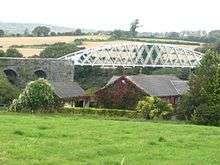Waterford and Kilkenny Railway
Waterford and Kilkenny Railway incorporated 21 July 1845.[1]
| Waterford and Kilkenny Railway | |
|---|---|
| Overview | |
| Locale | |
| Termini | Waterford city Mountmellick, Co. Laois |
| Operation | |
| Opened | 12 May 1848 |
| Closed | 1900 |
| Owner | Waterford and Kilkenny Railway Company |
| Technical | |
| Track gauge | 1,600 mm (5 ft 3 in) |
The aim was to create a series of railways which would connect Waterford, Cork, Dublin and Galway. The creation of such links was considered a good investment for the stock market but also intended to have a positive impact on businesses in Ireland and links to the rest of the UK.[1]
Kilkenny-Waterford Line
The first part of the rail line to be completed was the Kilkenny to Thomastown section. Work began in 1846 but the line didn't open until 12 May 1848 due to delays in waiting for other railway companies to finish connecting track. Thomastown station was a Tudor Revival building which opened 1848.[2][3] The line reached Seapoint Hill in 1850 and the rest of the track to Waterford was completed in 1853 with the opening of the station at Dunkitt.[4]
In 1850 the company applied for an Act to allow them to raise further funds. The long term goal being the trunk line to the midlands.[5][6] Another Act was put forward in 1866 to create a new company called the Central Ireland Railways. In anticipation of the increased range of the Waterford and Kilkenny Railway company the name was changed to the Waterford & Central Ireland Railway in 1868. The line from Kilkenny only reached Maryborough in 1867. The line to Mountmellick was opened in 1883 and that was as far as the Waterford & Central Ireland Railway got.
In 1900, as a result of Acts of Parliament, several important lines became part of the GS&WR system, including the Waterford and Central Ireland Railway and the Waterford, Limerick and Western Railway.[7]
The Thomastown Viaduct

The line from Thomastown to Jerpoint Hill, completed in 1850, was the section which needed the viaduct across the river Nore. Captain William Moorsom was the engineer who designed the structure of lattice woodwork beginning the work in 1846.[8] It was two hundred feet long and seventy-eight feet above the River Nore. At twenty-five feet wide, it was designed for two lines, although only one was built. When done was the longest single span viaduct in either Ireland or Great Britain.
The new viaduct had Charles Richard Galwey (1840–94) as the engineer.[9] The iron structure was completed in 1877. It replaced an older wooden viaduct which was feared to be unstable and dangerous. Throughout the 1850s there were reports on the safety of the structure and while all agreed it was safe it was still recommended to replace it with an iron viaduct which would need less maintenance.
See also
References
- The Railway Chronicle: Joint-stock Companies Journal. Register of Traffic, Shares, Engineering Improvements and All Matters Connected with Railways ..., Volume 1. J. Francis, 1845 - Railroads.
- "EARLY RAILWAYS". Irish Railway Record Society. Retrieved 16 February 2016.
- "Thomastown railway station". Retrieved 16 February 2016.
- "Waterford and Central Ireland Railway". Retrieved 16 February 2016.
- "Accounts and works of railways in Ireland: minutes of evidence". Retrieved 16 February 2016.
- "galway-kilkenny-railway-committee-1845". Retrieved 16 February 2016.
- "Viaduct details". Proceedings of the Institution of Civil Engineers, 1851 - Railway architecture - 5 pages. Retrieved 16 February 2016.
- Moorsom. "Description of the viaduct erected over the river Nore, near Thomastown". Retrieved 18 February 2016.
- "Thomastown viaduct". Retrieved 16 February 2016.